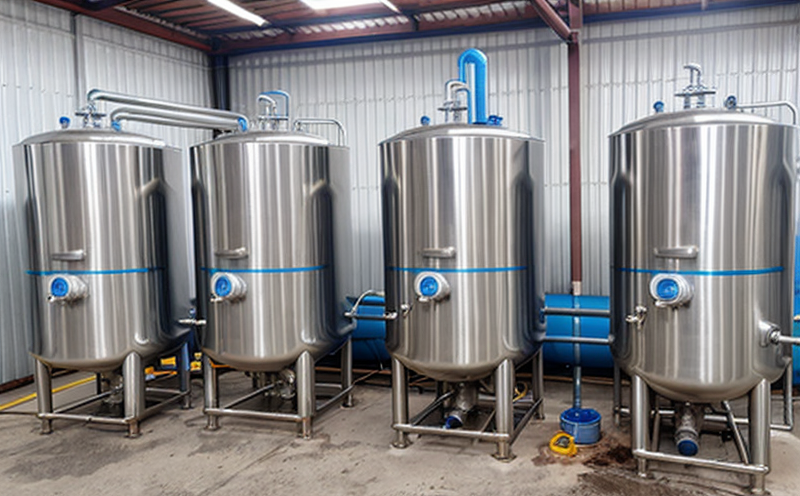ASTM D1067 Acidity Test in Boiler Water
The ASTM D1067-19 standard test method is crucial for ensuring that boiler water systems operate efficiently and safely. This test measures the acidity in boiler water, which can significantly impact the longevity of equipment and the overall efficiency of the system. Boiler water acidity levels are critical because high acidity can lead to corrosion, while low acidity may not effectively neutralize scale-forming compounds.
The ASTM D1067 standard specifies a titration procedure using phenolphthalein as an indicator. This method allows for precise measurement of the acidity in boiler water, which is essential for maintaining optimal operating conditions within the system. The test requires careful specimen preparation and handling to ensure accurate results.
The importance of this test cannot be overstated, especially given the high stakes involved with boiler operation. Boiler systems are responsible for generating steam, which powers turbines in power plants or provides heat in industrial settings. Any deviation from optimal operating conditions can lead to costly repairs, production downtimes, and potential safety hazards.
The ASTM D1067 Acidity Test is part of a broader suite of tests that help ensure the proper functioning of boiler systems. Other relevant tests include those for hardness, alkalinity, dissolved oxygen, and other parameters that influence system performance. By adhering to these standards, facilities can achieve regulatory compliance while also enhancing operational efficiency.
The ASTM D1067 Acidity Test is particularly important in the context of water treatment and industrial processes. In these sectors, boiler systems are critical components that require regular monitoring and maintenance. The test helps operators identify potential issues early, allowing for proactive interventions that prevent costly breakdowns.
Moreover, the ASTM D1067 Acidity Test is a key factor in ensuring water quality compliance with regulatory standards such as those outlined by the U.S. Environmental Protection Agency (EPA) and Occupational Safety and Health Administration (OSHA). By adhering to these standards, facilities can ensure that their boiler systems are not only efficient but also environmentally friendly.
Understanding the intricacies of the ASTM D1067 Acidity Test is essential for quality managers, compliance officers, R&D engineers, and procurement professionals working in this sector. These stakeholders need to be aware of the test's importance and how it fits into a broader strategy for maintaining boiler system integrity.
| Step | Action | Description |
|---|---|---|
| 1 | Collect a sample of boiler water | The sample should be representative and taken from the point where it is most critical to monitor acidity. |
| 2 | Add phenolphthalein indicator | Determine the endpoint of titration by adding sodium hydroxide until a permanent pink color persists. |
| 3 | Titrate to the endpoint | The amount of sodium hydroxide required is indicative of the acidity level in the boiler water. |
Applied Standards
The ASTM D1067 Acidity Test is widely recognized and applied across various industries, particularly those involving industrial boilers. This test is specifically relevant to the water treatment sector where ensuring high-quality boiler water is paramount.
The standard is referenced in several other international standards that address aspects of water quality and process control:
- ISO 9001 for Quality Management Systems
- ASTM C266-18 for Water Used in the Production of Cementitious Products
- EN ISO 5659-3:2013 for Industrial Water - Part 3: Boiler Feed Water
The ASTM D1067 Acidity Test is a fundamental part of these broader standards, ensuring that the water quality meets specific criteria necessary for safe and efficient operation.
By adhering to the ASTM D1067 standard, facilities can ensure compliance with regulatory requirements while also optimizing their processes. This not only enhances operational efficiency but also contributes to environmental sustainability by minimizing waste and reducing energy consumption.
Competitive Advantage and Market Impact
The ASTM D1067 Acidity Test provides a significant competitive advantage in the industrial sector, particularly for facilities that rely heavily on boiler systems. By ensuring optimal water quality through this test, companies can reduce maintenance costs, extend equipment lifespan, and minimize operational disruptions.
Facilities that consistently meet or exceed the standards set by ASTM D1067 are better positioned to secure contracts with stringent quality requirements. This is especially true in sectors like power generation, where reliability and efficiency are critical. Compliance with this standard can also contribute to a company's reputation for excellence, attracting clients who value sustainability and operational integrity.
The market impact of adhering to the ASTM D1067 Acidity Test extends beyond individual facilities. When industries collectively meet these standards, it contributes to broader environmental goals by reducing waste and minimizing the ecological footprint associated with industrial processes.
Use Cases and Application Examples
- Power Plants: Regular testing ensures that boiler water is not only clean but also efficient in its role as a heat transfer medium. This helps maintain the optimal operating temperature and pressure, crucial for generating steam efficiently.
- Manufacturing Facilities: In industries such as petrochemicals or pharmaceuticals, where high-quality steam is essential, ASTM D1067 ensures that boiler water meets stringent purity standards.
- R&D and Testing Labs: Research facilities use ASTM D1067 to validate the effectiveness of new treatments or processes aimed at improving boiler water quality. This helps in developing innovative solutions for enhancing performance and efficiency.
| Industry Sector | Description of Use Case |
|---|---|
| Petrochemicals | Ensuring steam purity for high-precision processes. |
| Agricultural Processing | Maintaining boiler water quality to prevent contamination of food products. |
| Pharmaceuticals | Supporting sterile environments by ensuring steam is free from impurities. |





